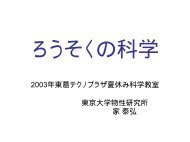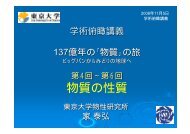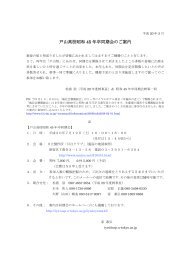Hofstadter butterflies in a modulated magnetic field - APS Link ...
Hofstadter butterflies in a modulated magnetic field - APS Link ...
Hofstadter butterflies in a modulated magnetic field - APS Link ...
- No tags were found...
You also want an ePaper? Increase the reach of your titles
YUMPU automatically turns print PDFs into web optimized ePapers that Google loves.
IYE et al. PHYSICAL REVIEW B 70, 144524 (2004)FIG. 10. Structure of the samples. (a) Sample A for the checkerboard<strong>field</strong>. (b) Sample B for the stripe <strong>field</strong>. The external <strong>field</strong>parallel to the network plane controls the magnetization of the ferro<strong>magnetic</strong>array. The amplitude of the spatially <strong>modulated</strong> <strong>magnetic</strong><strong>field</strong> can be changed by the azimuthal angle of the parallel<strong>field</strong>.III. EXPERIMENT WITH SUPERCONDUCTINGWIRE NETWORKSA. Experimental methodThe samples used <strong>in</strong> the present study were fabricated onsilicon substrates by the follow<strong>in</strong>g steps.(i) Electrode pads were first formed by electron beam lithographyand gold evaporation.(ii) The network pattern (square lattice) was def<strong>in</strong>ed byelectron beam lithography and the niobium wire networkwas formed by ion-beam sputter<strong>in</strong>g deposition and the liftoffprocess.(iii) A protect<strong>in</strong>g layer of germanium was deposited ontop of the wire network, so as to prevent oxidation of niobiumand to keep it from direct contact with the ferro<strong>magnetic</strong>material to be deposited next.FIG. 11. Magnetoresistance traces at different temperatures forsample A. These data were taken at =0, i.e., =0.FIG. 12. Evolution of the Little-Parks oscillation for sample Awith the value of (checkerboard <strong>field</strong>). The traces are verticallyoffset for clarity.(iv) An array of mesoscopic ferromagnets (cobalt ornickel) was placed on top by electron beam lithography, ionbeamsputter deposition, and liftoff.The crucial po<strong>in</strong>t <strong>in</strong> the fabrication was to achievegood positional and angular registration between thesuperconduct<strong>in</strong>g network and the overlaid ferromagnetarray.Two samples (A and B) were <strong>in</strong>tensively studied. Thesesamples represent the checkerboard <strong>field</strong> case (sample A)and the stripe <strong>field</strong> case (sample B), respectively. Thesuperconductor part of the sample consisted of a squarenetwork of 100100 unit cells, made of niobium wire150 nm wide and 40 nm thick. The lattice period was500 nm for sample A and 750 nm for sample B. For sampleA, 150200 nm 2 rectangular dots of 80-nm-thick cobaltwere placed on top of the center of every other bond wires<strong>in</strong> the y direction, as shown <strong>in</strong> Fig. 10(a). For sample B,250-nm-wide strips of 60-nm-thick nickel were placedon top of every other l<strong>in</strong>es <strong>in</strong> the y direction as shown <strong>in</strong>Fig. 10(b).Measurements of the superconduct<strong>in</strong>g properties wereconducted by use of a cross-coil superconduct<strong>in</strong>g magnetsystem, consist<strong>in</strong>g of a 6 T Helmholtz coil and a 1 Tsolenoid. The horizontal <strong>field</strong> was used to fix the magnetizationof the ferro<strong>magnetic</strong> array and thereby controlthe strength of the spatially vary<strong>in</strong>g <strong>field</strong> (parameter or ).The vertical <strong>field</strong> supplied the uniform <strong>field</strong> (parameter )for the network. The four-term<strong>in</strong>al resistance of the networkwas measured by a standard ac lock-<strong>in</strong> technique. Cryogeniccontrol was achieved by a variable temperature <strong>in</strong>sert Dewar144524-6








